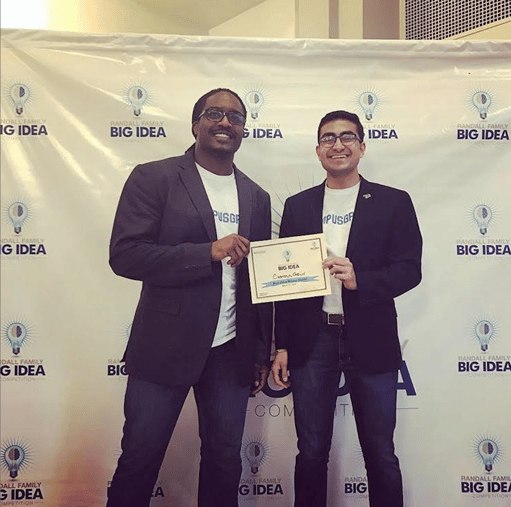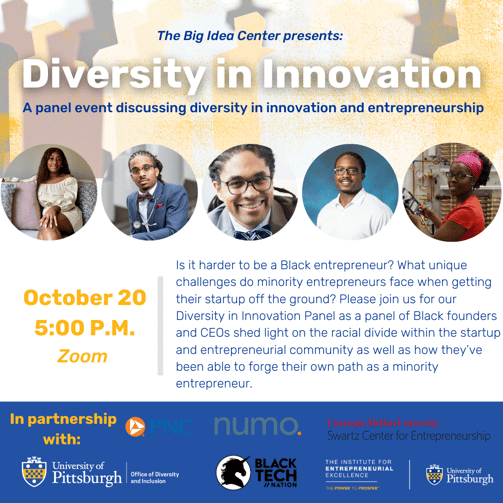 The CampusGrüv team -- Ron Idoko (pictured left) and Saket Rajprohat (pictured right) -- at the Randall Family Big Idea Competition.
The CampusGrüv team -- Ron Idoko (pictured left) and Saket Rajprohat (pictured right) -- at the Randall Family Big Idea Competition.
Diversity and inclusion and its effects around the world have become focal points for conversations and structural change in many organizations lately. Generally, we all agree that we should be inclusive of all types of people and build our work on a diverse foundation to give it strength, but this is something that I had questioned at one point. Of course, it is wrong to discriminate - but it seems natural to believe that we just get along better with people who think like us, act like us, and talk like us. Often though, even though it may sometimes be easier to get the work done, the ending result turns out to be a poor version of the product that could have been. When your work is not built on an inclusive foundation, it fails to reach the people that could benefit from it the most. This is something I have come to learn in my time working on CampusGrüv.
CampusGrüv is a startup social networking application that has been in development for the past several years, with plans to launch this year at Pitt. Our beginnings (and, honestly, our current stage) were fairly humble, with my business partner and CEO Ron Idoko attempting to address the issue of engagement in the campus space. Nowadays, with thousands of dollars going toward tuitions every year, sometimes it can feel confusing exactly where our money goes. Specifically, this is reflected in the United States, which has one of the highest college dropout and delayed graduation rates in the world, with a massive 30 percent of students not completing their degrees. Despite this confusing trend, it is very clear to see that a majority of universities now have diversified their student’s college experience to include a wide array of activities and organizations, highlighting the diversity of the students that make up these colleges. Nevertheless, this diversity has failed to attract the right people, with several of my own peers reporting how they have felt unfulfilled by their college experience and several universities reporting weak attendance among their programs.
So, what’s going on here? So much diversity in the college space, and yet so many students feeling unfulfilled. In our journey in making CampusGrüv, we have had this struggle as well. Working on his own initially, Ron wanted to make an app that would help to centralize all of the activities and happenings of the campus space onto one platform. He felt that if there was a way to offer a personalized experience for college, not only would it benefit student engagement on campus by providing direct access to the current events, but it would also allow all members of the community to feel connected to one another.
When Ron presented the idea to me, I quickly joined feeling excited about its potential. My task as Product Manager became to oversee the development of our application in Pakistan, using my Hindi skills to communicate with our team. In addition, we brought on a group of Pitt students who made up our marketing team. As our team grew, we began to see the benefits that came from having such a diverse team of people working with us. Our developers in Pakistan helped to provide insight into the development world while also giving us an outside perspective on how CampusGrüv would most benefit universities on a global scale. Our marketing team, all from different classes and diverse backgrounds, showed us how the student population is far from a monolith, and that marketing our application would need to take into account those diverse perspectives. Even Ron and I as a team with our Nigerian and Indian family heritages, respectively, found value in our partnership as we came to realize the power CampusGrüv could have within the realm of civic engagement and in empowering minority populations in college communities across the country.
Despite the progress we have made together, it has not come easy. With the diversity that we have build within our team, we have also had to work hard to ensure that we are inclusive of all the different cultures and perspectives within our company. To create this culture of inclusion, we had to learn a few lessons along the way. Below I have made a list of the top five things that have worked for us in building an inclusive work environment:
- Give time to make sure everyone’s voice is heard.
- Ensure there is time at every meeting or interaction to hear the opinions of all your team members. This can be something as simple as opening the floor to allow questions or ideas.
- When in conflict, value differences and unique perspectives.
- Your perspective on something might be influenced by your own life experiences and may not be taking into account the life experiences of someone else. Be sure to spend time in understanding where someone is coming from and fully hear out their point of view before approving or dismissing something you are unfamiliar with.
- Create specific relationships to provide safe spaces within the organization.
- Your partners, managers, and employees should always feel that they can express any concerns or advice they may have. Although you may feel that this should be a given, it can be more difficult for some people to express those thoughts. Selecting people to specifically engage with certain members within your company can help to create safe spaces in which your employees can feel open in expressing their views/opinions.
- Spend time every so often getting to catch up with your team.
- Work cannot always be simply about work, especially if you are wanting to create a productive environment. You need to keep in mind that the members of your company are people as well and have different things going on in their lives. This is even more important in a company made up of diverse people as the more you talk to one another, the more you learn about each other’s backgrounds and cultures, and the more you learn to work together successfully.
- Show your appreciation.
- This final note should be a given in any company, but in a diverse work environment, appreciation can be expressed in different ways to different people. Ensure that you are thanking your members for the work that they do in a way that they are receptive towards. Understanding what works best for them can often go a long way in creating long term relationships.
This list simply comprises what I have found to be valuable in creating an inclusive environment, but there are also plenty of other ways that you can help to develop this type of environment in your own company or workplace. As you go about creating your own projects and starting your own companies, keep in mind not only the value that can come from having a diverse team, but also how the need to continually practice inclusion habits within your workspace in order to maximize that value. The whole is always greater than the sum of its parts, but only when you are inclusive of all of those parts. Working with a diverse group of people can be tough, but when done right, you can end up making something pretty amazing.

Check out CampusGrüv and sign up to be notified when we launch at CampusGruv.com. CampusGrüv – Your Campus, With You.
Want to join the conversation about diversity within the world of innovation and entrepreneurship? Please join Pitt's Big Idea Center for their Diversity in Innovation event on Tuesday, October 20, 2020 at 5 PM as a panel of Black founders and CEOs (including CampusGrüv's very own Ron Idoko) shed light on the racial divide within the startup and entrepreneurial community as well as how they've been able to forge their own path as a minority entrepreneur. A Q&A session with the panelists is to follow.
Don't miss out on this much-needed discussion! Registration is required to receive the link and password to join the event. Register here.
